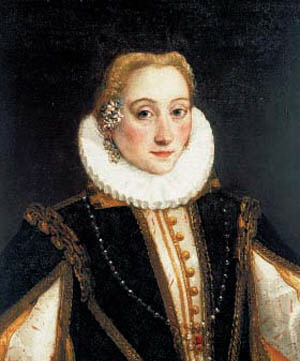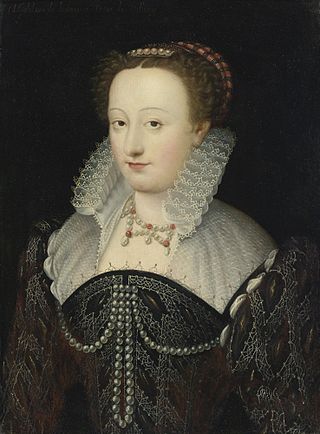
Nicole Estienne (c.1542-c.1588) was a French poet of the Renaissance.

Nicole Estienne (c.1542-c.1588) was a French poet of the Renaissance.
Her parents were Charles Estienne and Geneviève de Berly. Her father's family was influential in the printing business.
The writer Jacques Grévin became engaged to her and celebrated her in his collection L'Olimpe. The engagement was broken for unknown reasons. [1] Nicole then married Jean Liebault, a physician from Dijon.
She wrote several works, some of which have survived. In response to Philippe Desportes's misogynist writings, she defended women in her Stanzes. Her best known work is Les Misères de la Femme mariée, où se peuvent voir les peines et tourmens qu’elle reçoit durant sa vie, in which she condemned big age differences between spouses and domestic violence. [2]
Some of her poems were written as introductions to the work of other poets.

Vittoria Colonna, marchioness of Pescara, was an Italian noblewoman and poet. As an educated, married noblewoman whose husband was in captivity, Colonna was able to develop relationships within the intellectual circles of Ischia and Naples. Her early poetry began to attract attention in the late 1510s and she ultimately became one of the most popular poets of 16th-century Italy. Upon the early death of her husband, she took refuge at a convent in Rome. She remained a laywoman but experienced a strong spiritual renewal and remained devoutly religious for the rest of her life. Colonna is also known to have been a muse to Michelangelo Buonarroti, himself a poet.

Louise Charlin Perrin Labé,, also identified as La Belle Cordière, was a feminist French poet of the Renaissance born in Lyon, the daughter of wealthy ropemaker Pierre Charly and his second wife, Etiennette Roybet.

Renée of France, was Duchess of Ferrara from 31 October 1534 until 3 October 1559 by marriage to Ercole II d'Este, grandson of Pope Alexander VI. She was the younger surviving child of Louis XII of France and the duchess regnant Anne of Brittany. In her later life, she became an important supporter of the Protestant Reformation and ally of John Calvin.

Jacques Grévin (c. 1539 – 5 November 1570) was a French playwright.

Olimpia Fulvia Morata was an Italian classical scholar.
Jean Liébault was a doctor and agronomist, born in Dijon.

Pernette Du Guillet was a female French poet of the Renaissance.

Charlotte of Bourbon was a Princess consort of Orange as the third spouse of William the Silent, Prince of Orange, the main leader of the Dutch revolt against the Spanish. She was the fourth daughter of Louis III de Bourbon, Duke of Montpensier and Jacqueline de Longwy, Countess of Bar-sur-Seine.
Catherine Fradonnet, called Catherine Des Roches, was a French writer of the Renaissance.
Madeleine Des Roches was a French writer of the Renaissance. She was the mother of Catherine Fradonnet, called Catherine Des Roches, to whom she taught poetry, literature and ancient languages. She is a writer in the tradition of Christine de Pizan and others, working to establish a community of women writers.

Veronica Gambara was an Italian poet and politician. She was the ruler of the County of Correggio from 1518 until 1550.

Madeleine de l'Aubespine was a French aristocrat, lady in waiting to Catherine de Medicis, poet, and literary patron. She was one of the only female poets praised by "the prince of poets," Pierre de Ronsard and she was one of the earliest female erotic poets.

Giovanna d'Aragona was a patron of the arts, printers and religious reform in Naples during the Renaissance.
Jeanne de la Font (1500–1532) was a poet and patron of the French Renaissance.

Isabella di Morra was an Italian poet of the Renaissance. An unknown figure in her lifetime, she was forced by her brothers to live in isolation, which estranged her from courts and literary salons. While living in solitude in her castle, she produced a body of work which did not circulate in the literary milieu of the time. Her brothers eventually murdered her for her suspected secret romance.
Laura Terracina was an Italian poet from Naples during the Renaissance. She was the most published Italian poet of the sixteenth century.

Lucrina Fetti was an Italian painter born in Rome under the name Giustina She was the daughter of a lesser-known painter, Pietro Fetti, and the sister and pupil of the more distinguished painter of the family, Domenico Fetti. She accompanied her family to Mantua when her brother was invited to be court painter to Ferdinando Gonzaga, Duke of Mantua. On December 3, 1614, Duke Ferdinando exclusively gave Giustina a dowry of 150 scudi so she could become a Clarissan nun in the Convent of St. Ursula. Once she entered the convent, she chose to change her name to "Lucrina". She was known for her religious works from her family's workshop. They were mostly meant for decorations for the church and convent that were sponsored by Margherita Gonzaga, Duchess of Ferrara. She was also known for doing portraits of the women of the Gonzaga family.
Maria d'Aragona was the daughter of Duke Ferdinando di Montalto and Catalina Cardona and the granddaughter of King Ferdinand I of Naples, also called King Ferrante. As a child, Maria d’Aragona grew up in a castle with the poet Vittoria Colonna, who had married d'Avalo's nephew. It was here that Maria met Sannazaro, Tansillo, and Bernardo Tasso who would entertain her in later life at her own salons in Naples, Milan, and Pavia.
Marie de Romieu was a 16th-century French poet from Viviers, France. Although her exact date of birth is unknown, she was most likely born between 1526 and 1545, and died around 1589. Like her origins, most of her life remains a mystery. She is mostly known for her poetic discourse on the superiority of women, as well as an attributed French translation of a work by Italian author Alessandro Piccolomini, which provided behavioral and societal instructions for young ladies and their mothers.
Marie Le Gendre, Dame de Rivery, was a 16th-century French humanist, poet and writer on moral philosophy, associated with the late-16th-century revival of Stoicism.